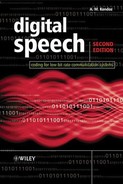Preface
Speech has remained the most desirable medium of communication between humans. Nevertheless, analogue telecommunication of speech is a cumbersome and inflexible process when transmission power and spectral utilization, the foremost resources in any communication system, are considered. Digital transmission of speech is more versatile, providing the opportunity of achieving lower costs, consistent quality, security and spectral efficiency in the systems that exploit it. The first stage in the digitization of speech involves sampling and quantizations. While the minimum sampling frequency is limited by the Nyquist criterion, the number of quantifier levels is generally determined by the degree of faithful reconstruction (quality) of the signal required at the receiver. For speech transmission systems, these two limitations lead to an initial bit rate of 64kb/s – the PCM system. Such a high bit rate restricts the much desired spectral efficiency.
The last decade has witnessed the emergence of new fixed and mobile telecommunication systems for which spectral efficiency is a prime mover. This has fuelled the need to reduce the PCM bit rate of speech signals. Digital coding of speech and the bit rate reduction process has thus emerged as an important area of research. This research largely addresses the following problems:
- Although it is very attractive to reduce the PCM bit rate as much as possible, it becomes increasingly difficult to maintain acceptable speech quality as the bit rate falls.
- As the bit rate falls, acceptable speech quality can only be maintained by employing very complex algorithms, which are difficult to implement in real-time even with new fast processors with their associated high cost and power consumption, or by incurring excessive delay, which may create echo control problems elsewhere in the system.
- In order to achieve low bit rates, parameters of a speech production and/or perception model are encoded and transmitted. These parameters are however extremely sensitive to channel corruption. On the other hand, the systems in which these speech coders are needed typically operate on highly degraded channels, raising the acute problem of maintaining acceptable speech quality from sensitive speech parameters even in bad channel conditions. Moreover, when estimating these parameters from the input, speech contaminated by the environmental noise typical of mobile/wireless communication systems can cause significant degradation of speech quality.
These problems are by no means insurmountable. The advent of faster and more reliable Digital Signal Processor (DSP) chips has made possible the easy real-time implementation of highly complex algorithms. Their sophistication is also exploited in the implementation of more effective echo control, background noise suppression, equalization and forward error control systems. The design of an optimum system is thus mainly a trading-off process of many factors which affect the overall quality of service provided at a reasonable cost.
This book presents some existing chapters from the first edition, as well as chapters on new speech processing and coding techniques. In order to lay the foundation of speech coding technology, it reviews sampling, quantizations and then the basic nature of speech signals, and the theory and tools applied in speech coding. The rest of the material presented has been drawn from recent postgraduate research and graduate teaching activities within the Multimedia Communications Research Group of the Centre for Communication Systems Research (CCSR), a teaching and research centre at the University of Surrey. Most of the material thus represents state-of-the-art thinking in this technology. It is suitable for both graduate and postgraduate teaching. It is hoped that the book will also be useful to research and development engineers for whom the hands-on approach to the base band design of low bit-rate fixed and mobile communication systems will prove attractive.
Ahmet Kondoz
